Kassel and its attractions
Kassel is a very green city and this is not surprising - 60% of the city is occupied by parks. The Karlsaue Park is very beautiful. It is a baroque palace and park ensemble on the bank of the Fulda River.
Kassel is an ancient city, it has a thousand-year history, survived many conflicts and wars, grew up, grew rich, was built ... In historical sources, the city was first mentioned in 913, the city received the status in 1189.
When, in 1567, the Landgraf of Hessen with its capital in Marburg was divided between the four sons of the Landgraf, the landgraf of Hesse-Kassel arose. Kassel became its capital and stronghold of Calvinism in Germany. In Germany, at this time, the Reformation was in full swing. In the 17th century, the city became a refuge for the Huguenots who fled from France from religious persecution.
In 1803, as a result of the Napoleonic wars, Landgraf became a principality, but soon Kassel was occupied by Napoleon, and in 1807, Kassel briefly became the capital of the Westphalian Kingdom, headed by Napoleon’s brother Jerome. As a result of the Austro-Prussian War, Cassel was occupied by Prussia in 1866.
In the XIX century. Kassel has become a major railway junction and a developed industrial center. Suffice it to recall that a very popular Volkswagen car - which, in Russian, means “people's car” - was made in the Kassel district of the town of Baunatal. In Baunatal, you can get from the center of Kassel by tram for 20 min.
During the Second World War, this plant was used for military purposes, therefore the Allied aviation tried to destroy him in the first place. As a result of the bombing, Kassel was destroyed by almost 90%, while the plant was not injured. In war, as in war. After the war, part of the buildings were restored and the city center was built in the style of the 50s.
Kassel has a university, a theater, wonderful museums: the Museum of Nature on Friedrichstrasse, the City Museum with an art gallery, as well as beautiful palaces, fortresses and a greenhouse. Once every five years the city hosts the Document (it.Documenta) - a well-known international exhibition of contemporary art. Kassel is decorated with works that were presented to the city by exhibitors.
Old Town Hall
The Old Town Hall is one of the main attractions of Kassel. It is located on the street. Königstraße (German Königstraße). Built in 1905-09's. Architect Karl Roth designed the building in the German neo-baroque style. An impressively beautiful building closes a small square in front of the Town Hall in the form of a square.
An elegant portico with Corinthian columns is crowned with sculptures, and a wide staircase is decorated with gilded sculptures of lions, which gives pomp to this luxurious complex of buildings.
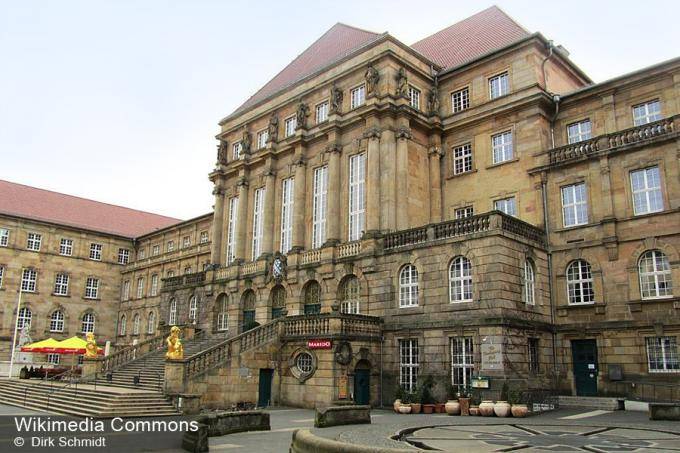
Kassel, Old Town Hall
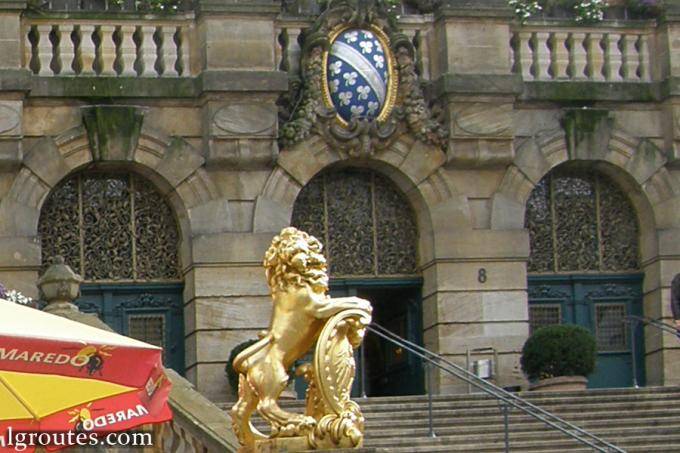
Kassel, Old Town Hall, fragment
Hessen State Museum
The Hessen State Museum in Kassel is located on the Brothers Grimm Square. The museum exhibits of the federal state of Hesse from ancient times to the present day. There is a rich exposition of applied art and folklore.
The museum was opened 23 August 1913 year to the thousandth anniversary of the city. However, the collection of the museum was founded much earlier. By order of Landgraf Charles, archeological excavations of northern Hesse were collected. Numerous exhibits reflect the history of the edge of the Neolithic era, the Bronze Age, the Iron Age and the early Middle Ages.
The basis of the arts and crafts collection is the collection of the Landgrave of the State of Hesse. The collection includes a collection of silver, medieval sculpture, objects of religious worship and altars. The treasures of William IV's Kunstkamera are also presented here. The collection of baroque art is made up of the collection of Landgrave Charles, the historical collection of glass is the collection of William VIII. There is an exposition of amber, ivory, earthenware, Meissen porcelain and exhibits of royal porcelain from China. There is an excellent exposure of precious stones, coins and medals.
The museum presents all areas and styles of decorative art: baroque art, historicism, modern, postmodernism, modern design. You can get acquainted with the various directions in the design of furniture and textiles.
The building was designed by architect Theodore Fisher in the style of late historicism with elements of the Renaissance. In the center of the composition is a tower, which gives lightness and elegance to this massive structure.
Fortunately, this monument of architecture of the beginning of the last century was not affected by the bombings during the Second World War, and the museum’s exposition also survived. In the postwar years, the exposure was added - Old Masters Gallery. Therefore, lovers of antiquity here expect unique exhibits, and the exhibition of decorative and applied art is a pleasure for all visitors.
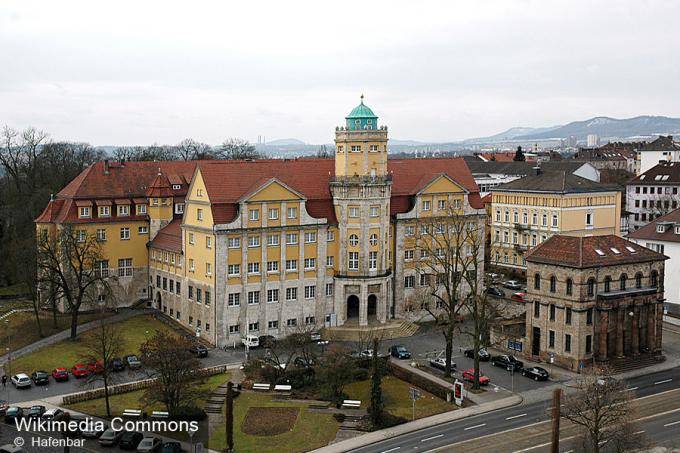
Hessen State Museum
Konigsplatz Square
The Konigsplatz Square (German Königsplatz) was created in 1767 during the modernization of the city by the design of the architect Simon Louis de Rue. Named in honor of Landgraf Frederick I. The square is located in the center of the city, it is a pedestrian zone. This is a great place for walking, relaxing and shopping.
The area was hit by bombing during the Second World War. In the postwar years it was restored and in general today it is built up with buildings of different architectural directions. Glavpochtampt was demolished and in its place a beautiful shopping center City Point was built.
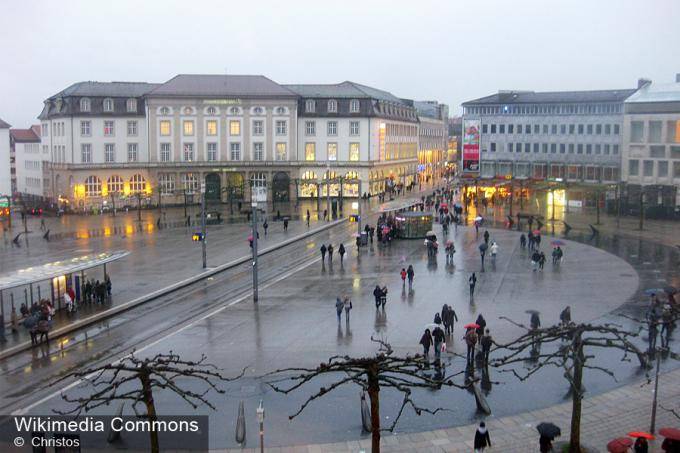
Konigsplatz Square.
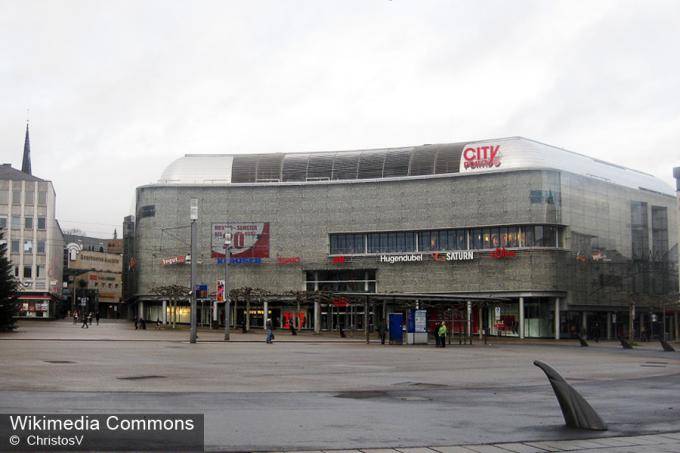
Königsplatz square, fragment
Friedrich Square in Kassel
Friedrich Square in Kassel (it.Friedrichsplatz) - one of the largest urban areas in Germany. Its size is 340 x 112. The square was planned in the XVIII century in the Baroque style and named after landgraf Frederick II.
The main decoration of the square is the Fridericianum - the first public museum in Europe. It also houses the famous Hessian Library.
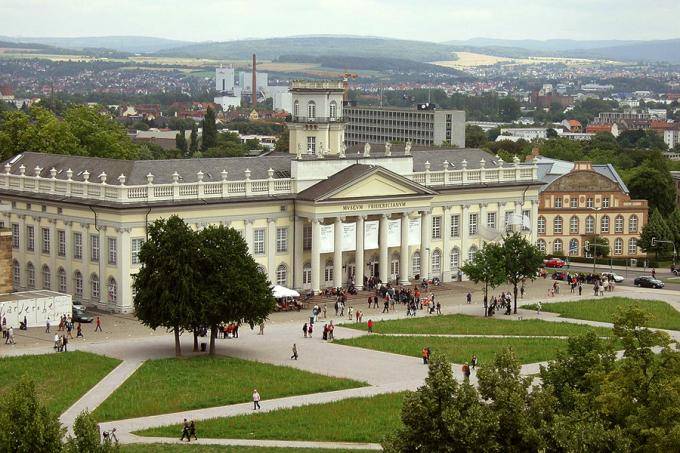
Friedrich Square in Kassel
From the bombing of the Second World War, the building was badly damaged. The surviving books were transferred to the university library, where they are still kept. Today the museum building is actively used for temporary exhibitions and various art festivals.
Ottonium
Ottonium (German Ottoneum) is a beautiful baroque building located on Friedrichplatz square. Ottonium, the first theater building in Germany, was built in 1603-1607. by order of Landgraf Moritz of Hesse-Kassel. The theater was named after the eldest son of Count Moritz - Otto.
After the city theater was built at the beginning of the 18th century, the Ottonium building was used as a repository of Hesse's relics, and an art gallery has been located here since 1697.
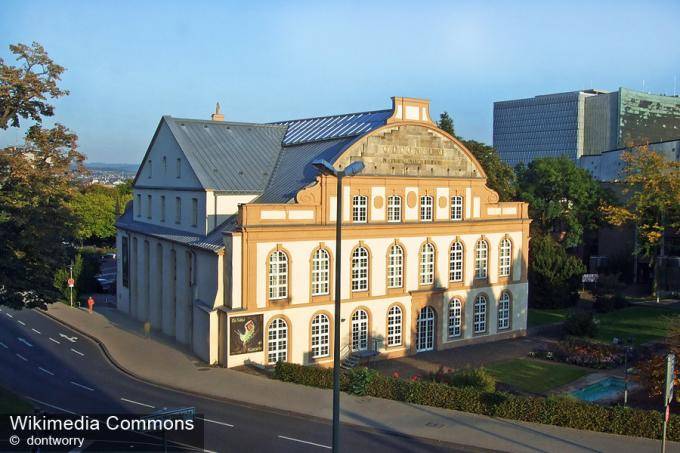
Ottonium
On the night of 22 on 23 of October, 1943, the Ottorium building was damaged by bombing and fire. Exhibits that did not have time to endure, unfortunately, burned. After the Second World War, the building was restored, here is located the city museum of natural history.
The collection of natural history was initiated by Landgrave Wilhelm IV, who collected rarities. The museum presents botanical, geological, zoological collections and aquariums. The most important exhibits are the oldest European systematic collection of plants "Herbarium Ratzenberger", collection of tree species "Schildbahshe Holzbibliothek" of the XVIII century., "Goethe's elephant" - one of the first prepared skeletons of large mammals in the world. The elephant's skull was temporarily transferred to the poet and naturalist I.V. Goethe for anatomical studies.
Federal Social Court building in Kassel
The building of the Federal Social Court in Kassel is located on Schlöfenplatz (German Schlieffenplatz). Built in 1938 year during the Third Reich to command the military district. In the architectural appearance of the building there are pomp features characteristic of this period. Architect Ernest Wendel.
During the Second World War, this part of the city almost did not suffer and the building was used as a hospital for American servicemen until 1947, then it was returned to the city. In the postwar years there was a hospital.
In 1955, the building was handed over to the Federal Social Court (German BSG), which is the highest court of justice, one of the five federal supreme courts.
Over time, the building decayed, was overhauled. The interior has been renovated and equipped with modern infrastructure. The architectural and spatial concept was revised and updated, and as a result, harmony of architecture and landscape was achieved. The court building is located near the famous Cascade Park Wilhelmshöhe - one of the most beautiful and largest landscape parks in Europe.
During the reconstruction, special attention was paid to the entrance to the building. The wide front staircase impresses with simplicity and symmetry, and the sculptural compositions of the sculptor Joseph Werkel give a certain solemnity to the entire structure. Spacious shady lawns, flower beds and the building of strict geometric shapes create a unique architectural and landscape complex.
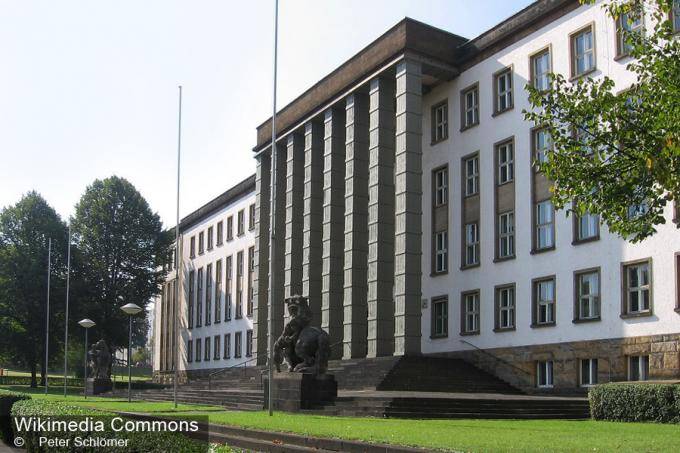
Federal Social Court building in Kassel
Brothers Grimm Museum
The Museum of the Brothers Grimm (it. Brüder-Grimm-Museum) is located in the Belfu Palace, built in 1714 by the design of the architect Paul de Rue in the Baroque style. In 1790, the building was rebuilt under the direction of Simon Luis de Rue, an astronomical observatory was equipped here.
The brothers Wilhelm and Jacob Grimm - the great German collectors of folk tales and legends worked in the city library of Kassel. It was a very fruitful period of their creative and scientific activities. In Kassel and its surroundings, they collected and recorded fairy tales.
In 1812, the city of Jacob and Wilhelm Grimm published “Children's and Home Fairy Tales”, then “Old Germanic Forests” and “Irish Folk Tales”. These works were widely recognized and were defended as doctoral dissertations. In 1835, Jacob Grimm published a very extensive study "German mythology"; this work is still considered a classic work in comparative mythology.
The exhibition of the Grimm Brothers Museum is devoted to the most important stages in the life and work of famous German philologists and folklorists, as well as the impact of their research on world science and culture. The museum has an excellent library and a collection of Jacob and Wilhelm’s personal belongings.
And the most valuable exhibit of the Grimm Brothers' Kassel Museum is a working copy of “Children's and Family Fairy Tales”, published in 1812 — 14, with handwritten litters and marginals of the Grimm brothers. The famous tales of the Brothers Grimm, which have become an integral part of the world cultural heritage, are presented in entertainingly decorated rooms.
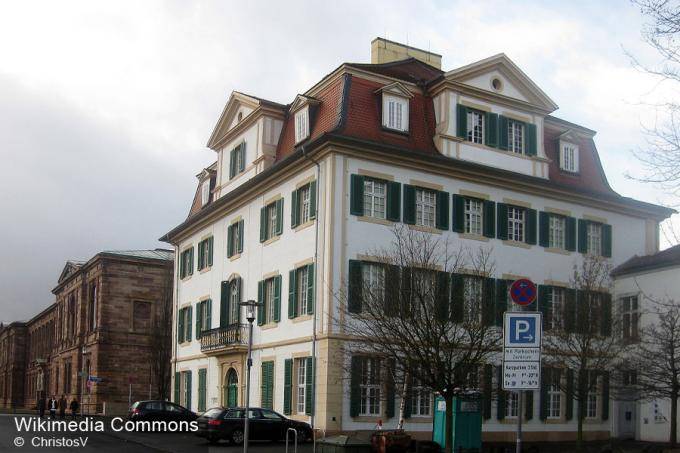
Brothers Grimm Museum
Here you can also see the personal room of fairy-tale tellers, left in the style of the first half of the XIX century, portraits of writers, pictures of their brother-artist Ludwig, manuscripts, posters, and even ... sweets, on the wrappers of which the favorite characters from the Grimm Brothers tales are painted - Little Red Riding Hood, Hansel and Gretel ...
Fulda
The beautiful full-flowing Fulda River flows through Kassel. Its calm and calm waters reflect old houses, trees lean their branches toward the water. On a hot summer day, the embankment of the river is the best resting place. Under the green trees in the shade you will find cafes and restaurants where you can sit, admire the amazing landscape, be alone with nature, without leaving the city.
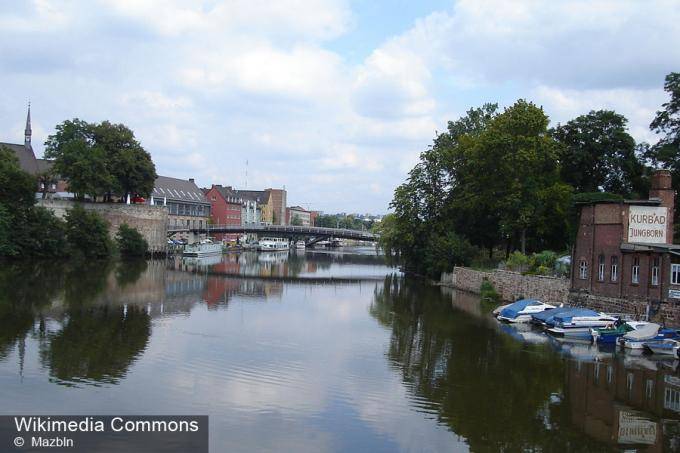
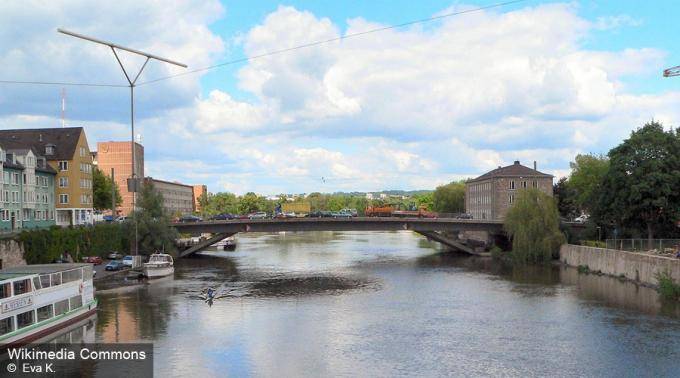
Fulda river
Church of St. Martin
The Church of St. Martin (German) was founded in 1330 during the reign of Landgrave Henry II. The foundation of the church was of great importance for Kassel in his confrontation with the Bishop of Mainz. The construction of the church was completed in 1337.
In the 16th century, the Reformation began in Germany and the church became Lutheran, and Kassel became a city supporting Protestants. Huguenots who were persecuted in France and other representatives of Protestantism rushed here.
In 1462, spiers were built on the three-story towers of St. Martin’s Church, and another elegant tower with a spire was added to 1483.
In the XIX century, the church was reconstructed, having completed the Renaissance-style floors with high spiers on the 4 towers. As such, the church stood until the 1943 year, when during the bombing of World War II the old medieval roof, storehouse and furnishings burned down. The left tower was destroyed, the walls and choir were damaged.
The church was restored in 1954-60. Modernist towers were built on the site of the destroyed Renaissance. The church in the new look perfectly fit into the landscape and looks very impressive.
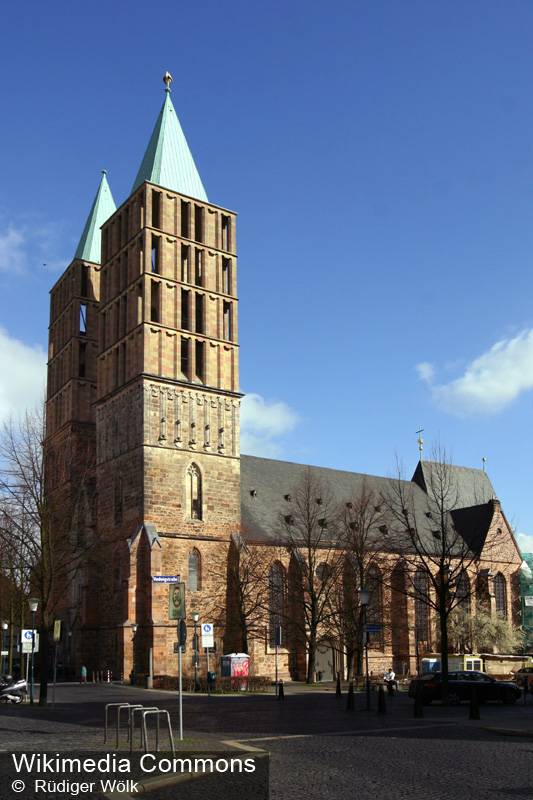
Church of St. Martin
Park Wilhelmshöhe
The famous Wilhelmshöhe Park is listed by UNESCO on the list of the cultural heritage of mankind. This is a unique park complex, one of the most popular in Europe. Deutsche Welle (Deutsche Welle) - the media company of the Federal Republic of Germany published the results of the most visited places in Germany. Rating of German sights was determined. The TOP-100 list consists of 100 objects, Wilhelmshöhe Park takes 53-place.
One of the most famous sights of Kassel and Wilhelmshöhe Park is the statue of Hercules, it has been a symbol of the city for 3 centuries. The colossal monument is placed on the pyramid, which, in turn, crowns the castle on the top of the hill. From the statue begins a grand cascade of Hercules decorated with grottoes and fountains, the waters of which descend from the height of 600 m above sea level. Cascade "Hercules" is located in the famous Wilhelmshöhe mountain park.
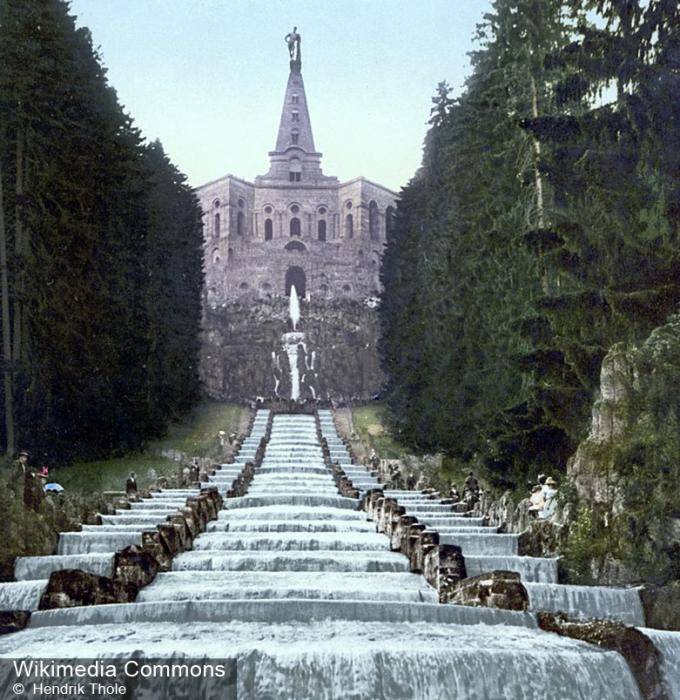
Park Wilhelmshöhe
Once upon a time, there was a monastery on the top of a mountain in the Hawkwood Forest (German: Habichtswald), which was closed during the Refraction period. In 1606, Landgraf Hesse-Kassel Moritz ordered to build a summer residence with a park and a hunting castle on the site of the monastery. Thus, the famous Wilhelmshöhe park was laid out, which was completed and altered during the 150 years.
His heir Landgrave Carl of Hesse invited Italian architect Francesco Gueriero to create an ensemble of cascades, fountains, pools and a palace. Francesco Guriero designed the grand cascade "Hercules", which impressed his contemporaries and still delights everyone who has been here.
An octagonal baroque Oktogon (Oktogon) palace was built on top of the mountain, on top of which they decided to install a statue of Hercules - a hero of ancient Greek mythology who possessed extraordinary power and accomplished feats. Hercules - the Latin name of Hercules, adopted in European art. By 1717, the statue was installed and since then Hercules has become a symbol of the city of Kassel.
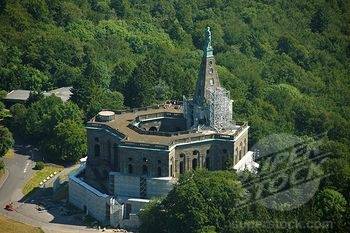
The sketches of the Hercules monument were made by the author of the whole project, the Italian architect Giovanni Francesco Gourniero at 1701. The sculptor from Augsburg, Johann Jacob Anthony, cast an exact copy of the ancient sculpture of Hercules in Franes in bronze.
The statue of Hercules weighs a ton of 3, is a 8,25 meter tall and consists of a metal frame covered with copper sheets.
The height of the whole building 70,5 m., The height of the three-story palace Oktogon near 30 m. Hercules stands on top of the pyramid, which is installed on the roof of the octahedral castle. The complex is set on the top of a mountain, the slope of which was complemented by terraces, and Hercules seemed to be floating in the air at dizzying heights.
Near the statue of Hercules there is an observation deck, to which you can climb a steep spiral staircase. From here there is a beautiful view of the panorama of the city of Kassel, you can see the mountain forests of Northern Hessen and stunningly beautiful landscape around.
Octagon Palace and cascades were built of tuff. This stone lends itself well to processing, but it is subject to erosion and weathering. Already in the XIX century, restoration work was carried out. In 1802-1804 the vaults and walls of the main building were reconstructed; in 1823, they overhauled the collapsed porch.
After 300 years after construction, a cardinal restoration of the palace, the pyramid and the monument was required. The Octagon Palace and the statue of Hercules in 2005 were covered with scaffolding, the restoration of the entire complex began, which lasted for several years.
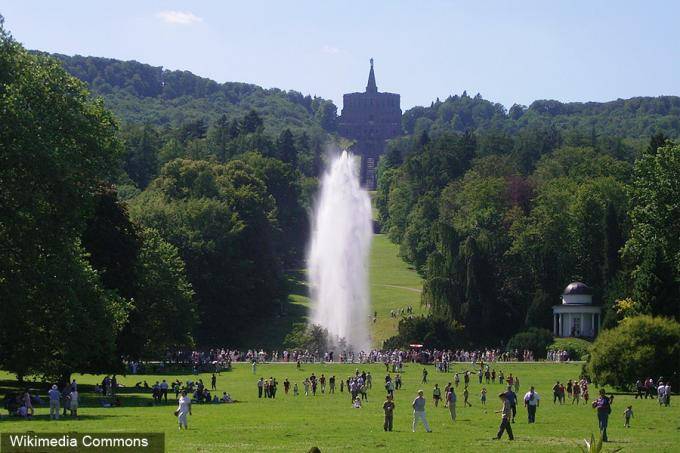
The water flows down the cascade steps, filling the pools and into the lower pond. From there, a powerful fountain beats, the height of the 50 jet. This is the culmination of an enchanting water show that lasts one hour. Then the water is turned off, everything calms down ... But this unique cascade remains, and the uniquely beautiful mountain landscape park Wilhelmshöhe calls you for a walk.
Please note: the water show on the Hercules cascade is held for an hour only in the summer period from May to October, twice a week on Wednesdays and Sundays, as well as on holidays. Starting the launch of water in 14: 30.
Park karlsue
Karlsuee Park (Germans Karlsaue) is located on the west bank of the Fulda River near the central city square Friedrichplatz (German Friedrichsplatz). This is one of the most beautiful parks in Kassel.
Founded in 1568 by order of Landgraf William IV. The Renaissance park was created on flat terrain, with many artificial lakes, canals, fountains, straight wide alleys and lawns for recreation.
At the beginning of the 18th century, during the reign of Landgrave Charles I, the park was significantly expanded, rebuilt in the Baroque style and named after him.
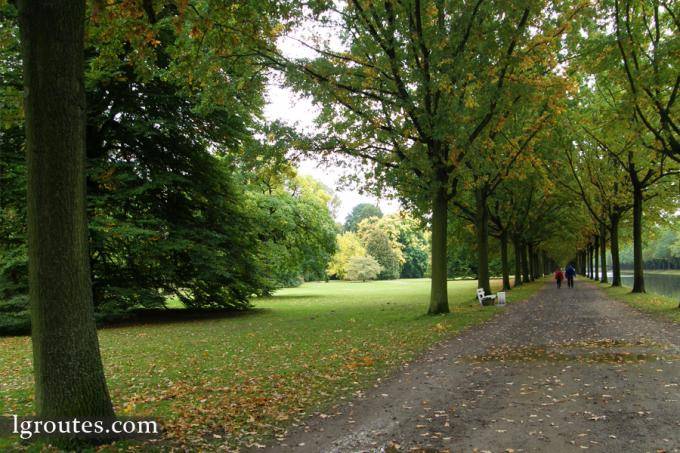
In 1785, under Landgraf Wilhelm of Hesse-Kassel, the park was redesigned into an English landscape park. From the baroque park there are canals, the central alley and part of the Orangery. The park has quiet walking paths, games and sports grounds, unique vegetation. You can enjoy the singing of birds. Ducks and swans swim in the ponds.
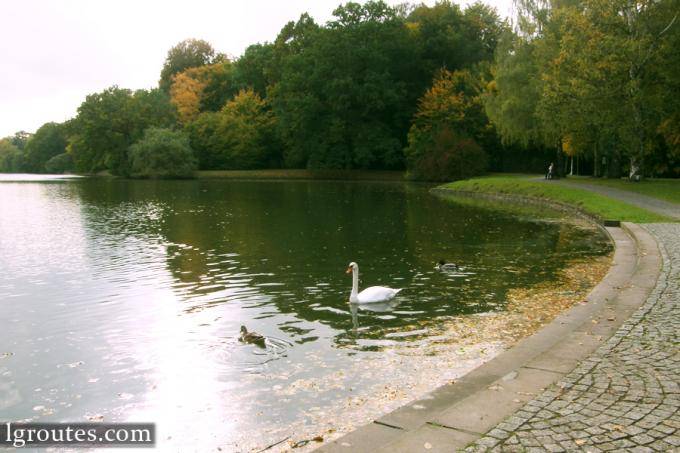
In the XVIII century, under the guidance of architect Johann Conrad Gisler, a baroque palace was built in the park. This is an impressively beautiful building - the center of the whole park composition. Inside - a luxurious marble bath decorated with sculptures by Pierre Etienne Mono. Currently, in this beautiful building there is an astronomy museum, an astrophysical room and a planetarium. The museum has a lot of technical exhibits from ancient times, the Renaissance to the present day.
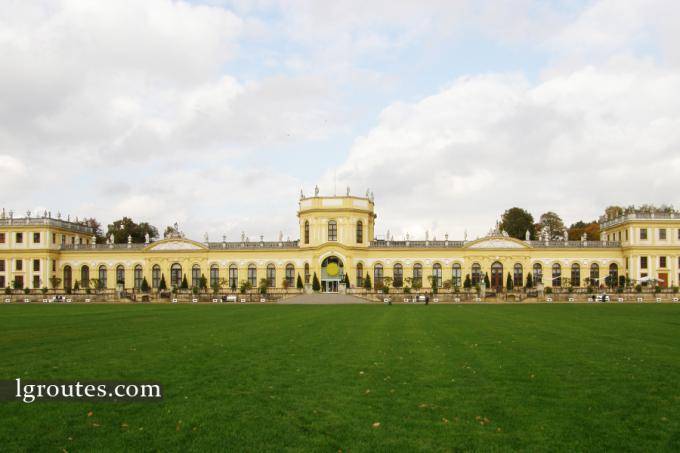
University of Kassel
The University of Kassel is a state university in the state of Hesse. Opened in 1971 year on the basis of the Higher vocational school and the German colonial school, which were founded in the XIX century.
The university specializes in engineering and environmental sciences, social research, art and teacher training. Faculties are located in different parts of the city, the main capitol "Golanishe Platz" (German.Holländischer Platz) is located on the territory of the former transport plant Henschel. Here is the main administration of the university.
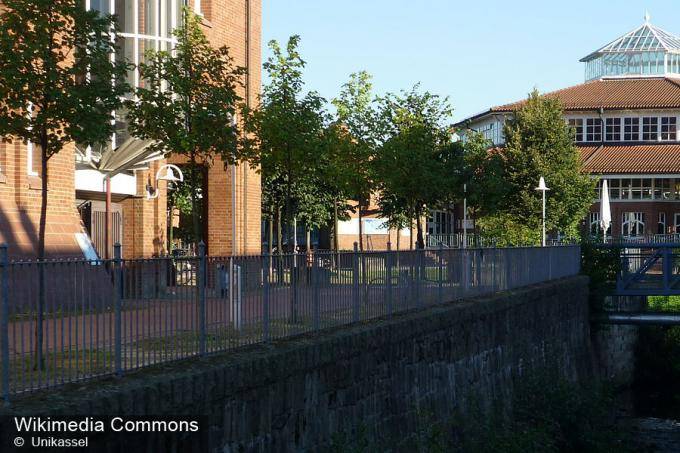
University of Kassel
The university has a wonderful scientific library, auditoriums, lecture halls - everything you need for successful study. More than 16 thousands of students from different countries study at this university. Educational buildings, recreation area and the original architectural structure, which houses the student dining room.
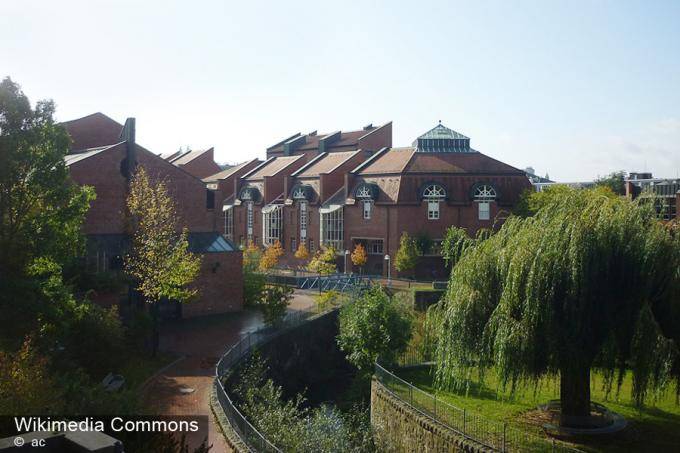
Student dining room of the University of Kassel
Information